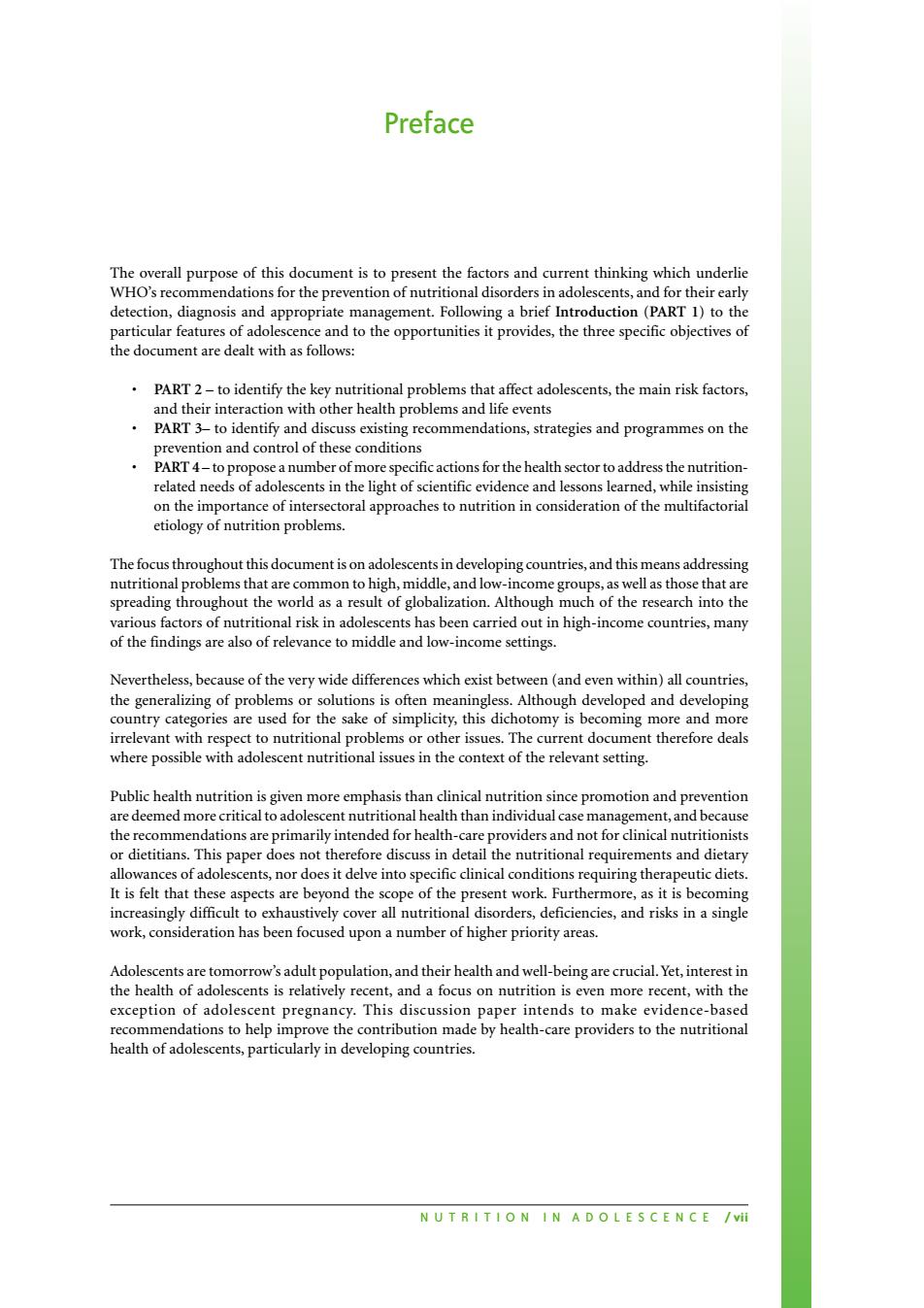正在加载图片...

Preface The overall purpose of this document is to present the factors and current thinking which underlie WHO's recommendations for the prevention of nutritional disorders in adolescents,and for their early detection,diagnosis and appropriate management.Following a brief Introduction(PART 1)to the particular features of adolescence and to the opportunities it provides,the three specific objectives of the document are dealt with as follows: PART 2-to identify the key nutritional problems that affect adolescents,the main risk factors, and their interaction with other health problems and life events PART 3-to identify and discuss existing recommendations,strategies and programmes on the prevention and control of these conditions PART4-to propose a number of more specific actions for the health sector to address the nutrition- related needs of adolescents in the light of scientific evidence and lessons learned,while insisting on the importance of intersectoral approaches to nutrition in consideration of the multifactorial etiology of nutrition problems. The focus throughout this document is on adolescents in developing countries,and this means addressing nutritional problems that are common to high,middle,and low-income groups,as well as those that are spreading throughout the world as a result of globalization.Although much of the research into the various factors of nutritional risk in adolescents has been carried out in high-income countries,many of the findings are also of relevance to middle and low-income settings. Nevertheless,because of the very wide differences which exist between(and even within)all countries, the generalizing of problems or solutions is often meaningless.Although developed and developing country categories are used for the sake of simplicity,this dichotomy is becoming more and more irrelevant with respect to nutritional problems or other issues.The current document therefore deals where possible with adolescent nutritional issues in the context of the relevant setting. Public health nutrition is given more emphasis than clinical nutrition since promotion and prevention are deemed more critical to adolescent nutritional health than individual case management,and because the recommendations are primarily intended for health-care providers and not for clinical nutritionists or dietitians.This paper does not therefore discuss in detail the nutritional requirements and dietary allowances of adolescents,nor does it delve into specific clinical conditions requiring therapeutic diets. It is felt that these aspects are beyond the scope of the present work.Furthermore,as it is becoming increasingly difficult to exhaustively cover all nutritional disorders,deficiencies,and risks in a single work,consideration has been focused upon a number of higher priority areas. Adolescents are tomorrow's adult population,and their health and well-being are crucial.Yet,interest in the health of adolescents is relatively recent,and a focus on nutrition is even more recent,with the exception of adolescent pregnancy.This discussion paper intends to make evidence-based recommendations to help improve the contribution made by health-care providers to the nutritional health of adolescents,particularly in developing countries. N UT RIT I O N I N A D O L E S C E N C E viiN U T R I T I O N I N A D O L E S C E N C E / vii Preface The overall purpose of this document is to present the factors and current thinking which underlie WHO’s recommendations for the prevention of nutritional disorders in adolescents, and for their early detection, diagnosis and appropriate management. Following a brief Introduction (PART 1) to the particular features of adolescence and to the opportunities it provides, the three specific objectives of the document are dealt with as follows: • PART 2 – to identify the key nutritional problems that affect adolescents, the main risk factors, and their interaction with other health problems and life events • PART 3– to identify and discuss existing recommendations, strategies and programmes on the prevention and control of these conditions • PART 4 – to propose a number of more specific actions for the health sector to address the nutritionrelated needs of adolescents in the light of scientific evidence and lessons learned, while insisting on the importance of intersectoral approaches to nutrition in consideration of the multifactorial etiology of nutrition problems. The focus throughout this document is on adolescents in developing countries, and this means addressing nutritional problems that are common to high, middle, and low-income groups, as well as those that are spreading throughout the world as a result of globalization. Although much of the research into the various factors of nutritional risk in adolescents has been carried out in high-income countries, many of the findings are also of relevance to middle and low-income settings. Nevertheless, because of the very wide differences which exist between (and even within) all countries, the generalizing of problems or solutions is often meaningless. Although developed and developing country categories are used for the sake of simplicity, this dichotomy is becoming more and more irrelevant with respect to nutritional problems or other issues. The current document therefore deals where possible with adolescent nutritional issues in the context of the relevant setting. Public health nutrition is given more emphasis than clinical nutrition since promotion and prevention are deemed more critical to adolescent nutritional health than individual case management, and because the recommendations are primarily intended for health-care providers and not for clinical nutritionists or dietitians. This paper does not therefore discuss in detail the nutritional requirements and dietary allowances of adolescents, nor does it delve into specific clinical conditions requiring therapeutic diets. It is felt that these aspects are beyond the scope of the present work. Furthermore, as it is becoming increasingly difficult to exhaustively cover all nutritional disorders, deficiencies, and risks in a single work, consideration has been focused upon a number of higher priority areas. Adolescents are tomorrow’s adult population, and their health and well-being are crucial. Yet, interest in the health of adolescents is relatively recent, and a focus on nutrition is even more recent, with the exception of adolescent pregnancy. This discussion paper intends to make evidence-based recommendations to help improve the contribution made by health-care providers to the nutritional health of adolescents, particularly in developing countries